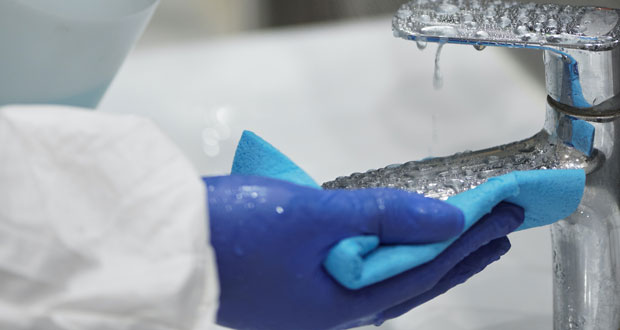Cleaning chemicals are intended to create environments that promote health and safety, however, if employees don’t have the right support, issues such as improperly mixed chemicals can lead to unfortunate consequences, as Scott Campbell, Global Product Manager Hydro Systems, explains.
The safety of cleaning professionals has become an even more important focus during the pandemic with the reliance on frequent and thorough cleaning, often without adequate supplies of the correct personal protective equipment (PPE). In addition, continuing supply disruption has meant the use of unfamiliar new products which – if applied in incorrect dilutions – can result in safety issues or ineffective cleaning. With new standards of cleanliness now top of mind, it is important not to forget to prioritise the wellbeing of frontline employees.
Promoting Safety Offers All-Round Benefits
Safe workplaces can help reduce staff turnover in the cleaning industry, and in related sectors like hospitality and foodservice. Estimates place normal industry turnover between 200 to 400 per cent, which makes it challenging to train employees properly; especially when it comes to chemicals to use, how to use them correctly, and which to avoid mixing.
If a workplace culture that values worker safety and wellbeing is created, employees may be more likely to remain in their roles longer. This improves engagement and helps reduce hiring and training costs for new workers. Enhanced safety measures can also mean fewer workplace injuries, limiting temporary replacements or reducing the burden of additional work for other employees. It can also mean fewer workers’ compensation claims, lawsuits, or potential fines from Health and Safety authorities. Reputation damage from high-profile accidents, or even disgruntled employees sharing their experiences about lapses in safety, can also be avoided.
Reviewing Inventory and Equipment
There are additional ways to enhance workplace safety, including reviewing chemical inventory. Weigh the pros and cons of products with contact times up to ten minutes, as a dwell time of this length can be difficult to achieve. Then, evaluate potential risks to workers. With increased sensitivity around efficacy and safety, it’s important to target solutions that are gentle on surfaces and people, but tough on pathogens. Narrowing the stocks of essential products also means employees have less training to absorb.
Install equipment that enhances safety, such as a chemical dispenser. This is a better alternative to the traditional ‘glug-glug’ method of mixing chemicals, where diluting manually leaves employees directly exposed to potential harm. Chemicals provide precise dilutions to maximise cleaning solutions, whereas improperly mixed solutions can leave behind harmful viruses, bacteria or fungi. Manual dilution can also lead to chemical overuse, which wastes product and can increase safety risks.
Choose dispensers that are easily installed and maintained, with a user-friendly interface and advanced technology for multiple dilutions. Additionally, utilising enclosures along with dispensers that contain chemicals that can be locked provides additional safety by preventing leaks and accidental exposure.
Finally, the utilisation of chemical dilution closed loop systems that can provide additional safety. Certain dispensers can match-up with inserts that are attached to chemical bottles that completely eliminate the chance for individuals to come in contact with the concentrated chemicals that are in the bottles.
Implement Training and a Culture of Safety
Thorough employee training is essential. Post-lockdown infections continue to impact staff numbers and there is the potential for workers to be asked to carry out unfamiliar cleaning tasks when others are absent. Workers should understand which chemical combinations can be harmful and how to properly clean and disinfect surfaces as part of a two-step cleaning process. Nevertheless, training and education won’t have the necessary impact unless it’s conducted within a workplace culture prioritising safety.
If managers lead by example, they’ll secure top-to-bottom support from employees who emulate their behaviours. Even a small strategically placed sign reminding employees to wear PPE emphasises and reinforces safety, as does enforcing accountability and celebrating successes.
Simplify and Improve
Despite the focus driven on patron safety through the reopening process, it’s essential to reassess workplace safety, especially for those maintaining facilities. Start by reviewing the types of chemicals and tools used to clean, sanitise and disinfect. Consider investing in equipment to simplify and improve the cleaning process.
Finally, training on best practices and promoting a culture of safety is key. This creates more confident and autonomous employees who, with an understanding of all aspects of cleaning, are more likely carry out their duties correctly and consistently regardless of the ongoing challenges.
For more information about Hydro Systems, the world’s largest independent manufacturer of chemical injecting, proportioning, dispensing and medicating equipment, visit www.hydrosystemseurope.com





